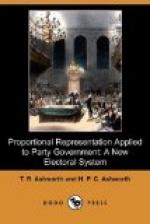this, he claims that it is quite possible to give fair
representation to the main parties and to small sections
at the same time. In illustrating the system
he avoids the issue as to the character of these sections
by giving them a “scientific” nomenclature,
such as Colour, Place, Pursuits, Qualities, &c.
These abstractions are very misleading, as attention
is diverted from the fact that they refer to voluntary
groups of men united for some political purpose.
The real question is, on what basis are these groups
likely to be formed? When the element of human
nature is taken into account it must be apparent that
they will be formed for the propaganda of some sectional
interest; some on a religious basis, others on a class
basis, &c. Now, if we were to ask each candidate
to declare his religion, we could easily take religions
as the basis of representation and allow proportional
representation to each religion; and similarly with
classes, races, and so on. But we could only
take one basis at a time, and the important deduction
is that if we were to take religions as the basis of
representation, the people would be induced to vote
according to religion; if we were to take classes,
according to class, and so on. Now, no one but
the fanatic or the demagogue will claim that the majority
is entitled to rule where religions only or classes
only are represented. The questions then arise—What
is the correct basis of representation? How should
the people be induced to vote? And the answer
is clearly that the people should be induced to vote
on questions of general public policy, on the leading
questions of the day which decide the party lines,
and that, therefore, the policies of the two main
parties should form the primary basis of proportional
representation. But the Hare system, by taking
individual candidates as the basis of representation,
induces the elector to vote on any basis or on sectional
lines. It promotes dissension instead of repressing
it, and instead of encouraging all sections to express
their opinion as to what is best for the general well-being,
it encourages them to express their opinion as to
what they imagine to be best for themselves. Public
opinion expressed on these lines would be worse than
useless. But Professor Nanson thinks that the
electors would still have regard for the main parties,
even though they grouped themselves into small sections.
He declares that “any party amounting to anything
like a quota would not only have two candidates of
its own—one Liberal and one Conservative—but
would also be wooed by candidates of both leading
parties.” We may well question whether
factions would trouble themselves about the main parties;
but, granting the assumption, the small parties might
just as well be single electorates as far as the main
parties are concerned. The Liberal candidates
might be successful in all of them, and the Conservatives
be unrepresented. The peculiar feature is that
the defeated Conservatives are expected to transfer
their votes to the Liberals to make up the quotas
for the small parties!




